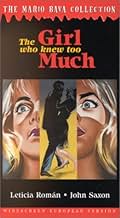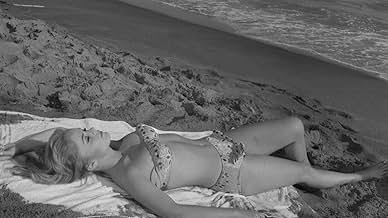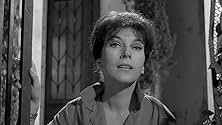IMDb RATING
6.9/10
5.7K
YOUR RATING
A mystery novel-loving American tourist witnesses a murder in Rome, and soon finds herself and her suitor caught up in a series of killings.A mystery novel-loving American tourist witnesses a murder in Rome, and soon finds herself and her suitor caught up in a series of killings.A mystery novel-loving American tourist witnesses a murder in Rome, and soon finds herself and her suitor caught up in a series of killings.
- Awards
- 1 win & 1 nomination
Letícia Román
- Nora Davis
- (as Leticia Roman)
- …
Walter Williams
- Dr. Alessi
- (as Robert Buchanan)
Giovanni Di Benedetto
- Professor Torrani
- (as Gianni De Benedetto)
Franco Moruzzi
- Policeman
- (as Franco Morici)
Dante DiPaolo
- Andrea Landini
- (as Dante Di Paolo)
Mario Bava
- Uncle Augusto
- (uncredited)
Geoffrey Copleston
- Asylum employee
- (uncredited)
Adriana Facchetti
- Woman in Sguattera Restaurant
- (uncredited)
Storyline
Did you know
- TriviaMario Bava was a big fan of Alfred Hitchcock, and Hitchcockian touches abound in the film, including a cameo by the director. In the scene where Letícia Román is in her bedroom at Ethel's home, the portrait on the wall with the eyes that keep following her is that of Mario Bava.
- GoofsWhen Nora answers the phone in the Torrani house, "hello" is heard before she speaks, even while the receiver is being lifted to her mouth.
- Quotes
Nora Davis: [into the phone] Oh mother, murders don't just happen like that here.
- Alternate versionsAIP released this as The Evil Eye, a recut version with material used just in some countries out of Italy.
- ConnectionsFeatured in Mario Bava: Maestro of the Macabre (2000)
- SoundtracksFurore
(Appears in the Italian version)
Sung by Adriano Celentano
Written and Composed by Adriano Celentano (as Adicel) and Paolo Vivarelli (as Vivarelli)
Published by Edizioni Nazionalmusic and Disco Jolly
Featured review
Coming out in 1963, The Girl Who Knew Too Much is not as ground-breaking as other Mario Bava efforts but it's still every bit as stylish and suspenseful. The plot of the film, convoluted and filled with twists and red herrigns galore, anticipates the giallo cycle of the late 60's. Of course one year later the director would practically define the style with Blood and Black Lace, introducing other genre staples like the black-gloved killer, the garish colours and the gore but that doesn't detract from the ifluential status of this proto-giallo.
As the title imples, The Girl Who Knew Too Much is with one foot firmly set in Hitchcock territory, but whereas Hitch films had a tendency of trying to be too many things at once (little bits of comedy, romance etc) something I always considered distracting, Bava allows nothing to come between him and his goal: a suspenseful horror thriller.
The chiaroscuro photography is simply beautiful to look at, light and shadow play off each other in expressive ways, not unlike film-noir. Leticia Roman's face is at times only half-lit to stress her confusion, while in other set-pieces dark figures stand out against fully lit backgrounds. Bava is famous for being one of the best visual directors in the history of the medium for good reason. His black and white work is as good as his colour films.
Minor quibbles I had with the film include that many scares turn out to be false, the first person narration (another film-noir influence) and the implied possibilities in the ending *was it all a dream?* Leticia Roman and John Saxon hit it off with great chemistry, the DP work is fantabulous, the opening 15-20 minutes leading up to the first murder are among the best 20 minutes in 60's horror and this an all around accomplished horror film that deserves every fan's attention.
As the title imples, The Girl Who Knew Too Much is with one foot firmly set in Hitchcock territory, but whereas Hitch films had a tendency of trying to be too many things at once (little bits of comedy, romance etc) something I always considered distracting, Bava allows nothing to come between him and his goal: a suspenseful horror thriller.
The chiaroscuro photography is simply beautiful to look at, light and shadow play off each other in expressive ways, not unlike film-noir. Leticia Roman's face is at times only half-lit to stress her confusion, while in other set-pieces dark figures stand out against fully lit backgrounds. Bava is famous for being one of the best visual directors in the history of the medium for good reason. His black and white work is as good as his colour films.
Minor quibbles I had with the film include that many scares turn out to be false, the first person narration (another film-noir influence) and the implied possibilities in the ending *was it all a dream?* Leticia Roman and John Saxon hit it off with great chemistry, the DP work is fantabulous, the opening 15-20 minutes leading up to the first murder are among the best 20 minutes in 60's horror and this an all around accomplished horror film that deserves every fan's attention.
- chaos-rampant
- Aug 7, 2008
- Permalink
- How long is The Evil Eye?Powered by Alexa
Details
- Runtime1 hour 26 minutes
- Color
- Sound mix
- Aspect ratio
- 1.66 : 1
Contribute to this page
Suggest an edit or add missing content

Top Gap
By what name was La ragazza che sapeva troppo (1963) officially released in India in English?
Answer




























